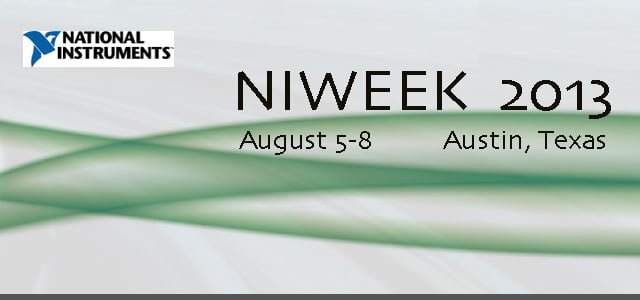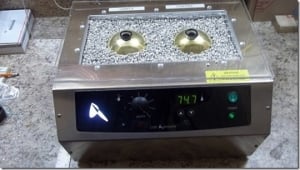Photo: The Neo-Coulombic booth with Dr. Dennis Cravens at NIWeek 2013.
Last year’s NIWeek 2012 was a pageant of LENR with multiple events bringing condensed matter nuclear scientists from all over the world to the Austin, Texas showcase.
This year, National Instruments chose to focus on conventional energy technologies, with one exception: Dennis Cravens‘ demonstration of anomalous heat generated by … er, well, what could that have been?

The device consisted of “two simple spheres, a control with a little sand (a bead “bath”), and a sample.”
The unusual thing about this was that the sample (L) ran hotter than the surrounding material it was in, or the control (R), by about 4 degrees C.
“Most people that stopped to look at it were software or electrical engineer types, and they seemed to receive it well,” says Cravens. “I would say only 2 out of the hundred+ people had negative statements – at least at the booth. Some may have laughed later, but most were very much interested and had very intelligent questions.”
Oddly, most visitors to the booth did not speculate as to the operation, but focused on a more practical query.
“The most common questions centered on marketing – what would it cost, can you scale it up, and when will it be available?”
What could be making the heat? How can a small ball get hotter than the sand it’s in?
“It was clear that something inside was producing heat. Most people seemed to be satisfied with the D + D to Helium pathway. The most pleasing response was: can you make me a charger for my Tesla?”
Not everyone was satisfied with the display.
“A few software types suggested that a single line of LabVIEW code could have given “fake” heat levels. Thus, we omitted the software and graph the second day. Instead we just read the temperature directly of the Agilent so there could be no question of sneaky behavior.”

“I got some applause. Many took pictures. Many came over to exam the material. A few kids wanted some of the gold-looking brass dust from the cutting.”
Cravens describes the experiment by beginning with one of the basic laws of thermodynamics: heat will only flow from a hot object to a cold one.
The small sphere was hotter than its bead bath, so it must necessarily contain a heat-producing source.
At the show, he suggested a mechanism:
You look around the exhibit floor and see hundreds of people but none are touching each other. A physicist would say that deuterium atoms in equilibrium at low temperatures would never interact.
However if some one yells “fire, fire!”, there would be massive interactions at the doors. People would be trampled. Some would be injured. There can be a lot of unexpected interactions when you have a dynamic movement of deuterium.
Here we have deuterium trying to move through the vacancies of the metal lattice that are no bigger than an atom. It is not unrealistic to think some will get trampled. Not only that, the carbon that holds the metal lattice has a size just matched to the black body radiation wavelength at the operating temperatures.
In this analogy, it is like people are having to go through a door way that is vibrating.
Hmm, a lesson with a little mystery left to figure out.
“What NI does is take complex problems and reduce them to the size of the team.” says James Truchard, CEO of National Instruments, the company he founded.
Cravens, who’s been both a research scientist and a teacher, agrees.
“My philosophy is to support and recognize those that are doing good and those that are trying to learn more. Kids live for recognition and praise. I disagree with the current trend in education that tries to cookie-cut all the courses.”
“I feel the reason that America is known for innovation is because of the range of teaching and the creative spirit teachers have had.”
Demonstration experiments that engage minds through wonder, and explanations that use common experiences as analogy, can teach both young and old.
Education should go beyond the “marginal improvement of existing development” and Dennis Cravens is using cold fusion to do it.
Related Links
NIWeek 2013 features Dennis Cravens experiment
Cold fusion-powered car engineer has history of discovery
The Doctor Is Very In: Dr. James Truchard’s Quest For Endless Innovation by Lydia Dishman on FastCompany.com



